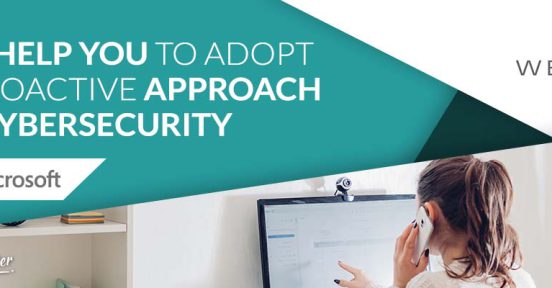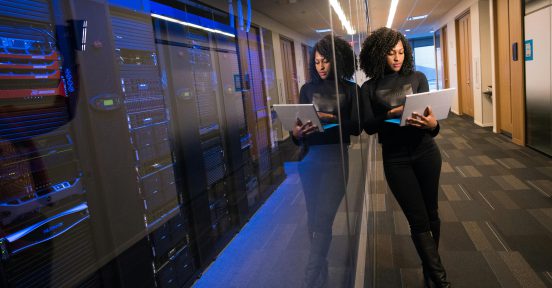26 . 06 . 2023
What are the cybersecurity services a company needs?
Avoid loses, protect IT infrastructure and data from digital threats with cybersecurity services. Find out which ones are right for your company.
Table of contents
Cybersecurity services help maximize the confidentiality, availability, and integrity of data and control the risk of financial loss. Find out what they consist of and which ones are right for your company.
Cybersecurity services are those offered to protect computer systems, computer networks, and data from malicious attacks. Some key services are Vulnerability Analysis, Pentesting, Ethical Hacking, SOC Monitoring, and staff awareness. It is important to note that to be effective, these services must be provided by specialized and experienced companies.
In this article, we take a closer look at these types of services and what they are used for. We also break down the different cybersecurity services and their functions. Finally, we help you find out which of these solutions are right for your company.
Cybersecurity services, what are they, and what are they for?
Cybersecurity services are those offered to protect computer systems, computer networks, and data from malicious attacks. These threats may include hacker attacks, malware, information theft, phishing, social engineering, and other forms of intrusion or exploitation of information security vulnerabilities.
To prevent information security incidents, the cybersecurity service provider may offer services such as:
- vulnerability analysis, pentesting, and/or Ethical Hacking,
- SOC (Security Operation Center) monitoring,
- data loss prevention and
- employee awareness.
In this way, the organization can safeguard as much as possible the integrity, availability, and confidentiality of digital information, devices, and assets of the organization.
What are the cybersecurity services a company needs?
For this to be possible, the cybersecurity service provider must offer a wide range of options. In the following, we describe which are, in our opinion, the most relevant ones:
-
IT Audit
This consists of an internal analysis of the IT platform and how it impacts business processes. For this purpose, a diagnosis of the technological infrastructure is performed, with the purpose of evaluating and identifying the existing risks and providing recommendations to optimize the platform.
As a result, the organization achieves a high degree of maturity in its processes and minimizes partial and/or long-term service losses.
At Wezen, we work with the following methodologies:
-
- CIS Controls: CIS controls consist of a list of globally accepted best practices developed by cybersecurity IT experts. Thus, an organization’s IT infrastructure is controlled with these parameters to mitigate the most common attacks against systems and networks.
- NIST Cybersecurity Framework: This framework compiles best practices (ISO, ITU, CIS, NIST, among others) and groups them according to affinity. It focuses on the use of business drivers to guide cybersecurity activities and consider cyber risks as part of the organization’s risk management processes.
The framework consists of three parts:
-
- Framework Core: This is a set of cybersecurity activities, expected outcomes, and applicable references that are common to the entire critical infrastructure. For this analysis, industry standards, guidelines, and practices that facilitate the communication of cybersecurity activities and their results throughout the organization are taken into account.
This framework seeks to develop 5 actions related to cybersecurity: identify, protect, detect, respond, and recover.
-
- Framework Implementation Tiers: The implementation tiers allow the organization to be categorized in a predefined threshold. This is determined by current risk management practices, the threat environment, and legal and regulatory requirements. As well as the business objectives and mission and the company’s own constraints.
- Frameworks Profile: Profiles are used to describe the current state and target state of specific cybersecurity activities. Differential analysis between profiles allows the identification of gaps that should be managed to meet risk management objectives.
In summary, the framework provides a common taxonomy and a mechanism for organizations to describe their current and desired target cybersecurity posture. At the same time, assess and prioritize opportunities for improvement and analyze progress toward the desired goal. It also helps communicate among internal and external stakeholders about cybersecurity risks.
-
Pentesting
This is one of the actions within the framework of the CIS controls detailed above.
Through the simulation of an attacker’s objectives and actions, the effectiveness and resistance of the company’s assets are tested. This action is performed by identifying and exploiting weaknesses in people, process, and technology controls.
-
Ethical Hacking
Ethical Hacking is a tool that puts companies one step ahead of real attacks. It is a lawful practice that involves ethical hackers who simulate an attacker who wants to harm the system or infrastructure. Their goal is to find vulnerabilities that can be exploited and that could mean security breaches for customers.
This type of action can be developed in two ways:
-
- External analysis: The ethical hacker acts on all the client’s public services, such as websites and servers. For example, in the case of Wezen, our experts include in this type of analysis:
- the security, access, control, and whether changes can be made to the website
- access to databases and confidential information
- server access
- identification of unnecessarily open ports
- DNS and SSL certificate testing
- metadata in documents, among others.
- External analysis: The ethical hacker acts on all the client’s public services, such as websites and servers. For example, in the case of Wezen, our experts include in this type of analysis:
-
- Internal analysis: This focuses on what a malicious user can do within the network or what could happen, for example, in the case of ransomware.
In our case, the specialists evaluate at this point the security in:
-
-
- the Wi-Fi network
- the internal servers and core devices
- browsing and the possible existence of viruses
- IP telephony, printers, and monitoring cameras
- shared folders, among others.
-
-
SOC/NOC Monitoring
Real-time IT monitoring is the monitoring and detection of problems in an organization’s computer systems and networks as they happen. This type of software collects and analyzes data in real-time, allowing IT teams to detect and resolve incidents before they become major problems.
In this category, we can identify monitoring:
-
- NOC (Network operation center) serves to see availability, usage, and other aspects referred to the infrastructure; such as, for example, if a server is shut down.
- SOC (Security Operation Center) is dedicated to everything related to cybersecurity, such as access, hacking attempts, etc.
The main uses of real-time monitoring include:
-
- Preventive maintenance: this allows identifying problems in computer systems and networks before they produce interruptions or failures.
- Early response to incidents: Upon detection of threats to the organization’s IT security, it minimizes downtime and damage.
- Performance optimization: For example, it allows detecting bottlenecks, identifying areas of low performance, and generating reports to improve efficiency (NOC).
- Regulatory compliance: Through the monitoring of sensitive data, this type of monitoring can warn of unauthorized access (SOC).
Therefore, real-time IT monitoring is a key piece to preventing, detecting, and resolving security incidents and failures in the performance of infrastructure and networks with agility.
-
Creation of backup copies
One of the key cybersecurity services is file backup, as it ensures the availability and integrity of data in case of incidents. By means of this action, it is possible to:
-
- Prevent data loss in the event of a cyberattack, human error, system failure, among other causes. In the event of such events, ensure the recovery of updated and historical information.
- Protect against ransomware, which consists of kidnapping data through encryption and requesting a ransom to recover the data. If there is an up-to-date backup, this type of attack would be rendered ineffective.
- Ensure regulatory compliance through adequate protection of information and its availability.
This cybersecurity service includes support and administration of backup jobs, configuration of new backup servers, and storage. As well as error diagnosis, storage management, and delegation for corporate archiving.
-
IT security awareness and training
This consists of the implementation of training programs for employees. Thus, it is possible to train them with the best security practices so that they can identify threats and contribute to preventing social engineering attacks.
-
Information Security Management System (ISMS)
An ISMS is a part of the overall management system, based on an enterprise risk approach. It is established to create, implement, operate, monitor, review, maintain, and improve information security.
The ISMS makes it possible to know the risks to which the information is subject. At the same time, it assumes, minimizes, transfers, or controls them by means of a defined, documented, and known system by all the employees of a company.
It is important to emphasize that the relevance of having an ISMS is that it allows continuous updating.
-
Firewall in the cloud
This cybersecurity service consists of implementing devices for the creation of secure networks. Its objective is to provide comprehensive, integrated, and automated protection against emerging and sophisticated threats.
In this way, the organization can protect its virtual environments in the public, private, and hybrid cloud.
How do I know which cybersecurity services are right for my organization?
We’ve seen that there are a wide variety of cybersecurity services out there, and knowing which tools and practices are right for your organization can be a challenge.
That’s why it’s important to have an IT service provider that has experience with cybersecurity solutions, uses industry best practices, and works with leading product manufacturers. Only then can you achieve a complete solution to improve your organization’s cybersecurity.
As a result, you will get vulnerability remediation and prevention of system attacks. At the same time, you will be able to avoid service interruption and loss of data or money that may affect the corporate image.
At Wezen we have specialists with more than 10 years of experience in cybersecurity, information management systems, and IT audits. They are also constantly reviewing and learning about new technologies and methods used by attackers.
This is how we work so that our cybersecurity services provide the most updated practices and tools in the market.


